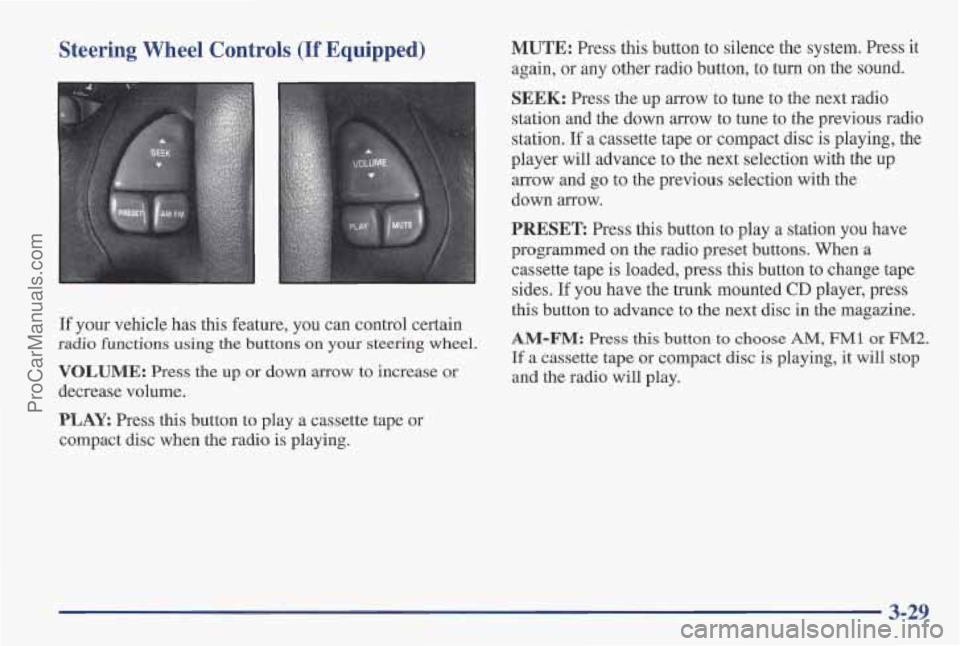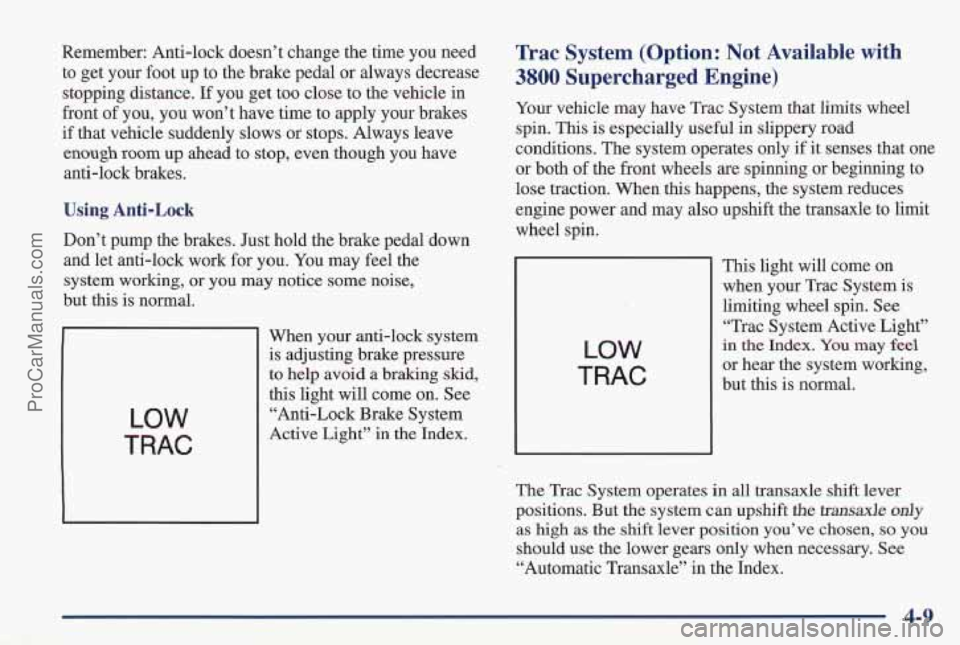Page 75 of 419

v Section 2 Features and Controls
Here you can learn about the many standard and optional features on your Pontiac, and information on starting,
shifting and braking. Also explained are the instrument panel and the warning systems that tell you if everything is
working properly
-- and what to do if you have a problem.
2-2
2-4
2-8
2- 10
2-12
2-15
2-15
2- 16
2-18
2-19
2-24
2-29
2-30
2-3 1
Important Information About Keys
Door Locks
Remote Keyless Entry Battery Replacement for RKE
Preventing Theft
of Your Vehicle
New Vehicle “Break-In”
Ignition Positions
Tips on Starting Your Engine
Using the Engine Coolant Heater
Automatic Transaxle Operation
Parking Brake Guidelines
Important Information on Engine Exhaust
Operation of Your Windows
Adjusting the Tilt Steering Wheel 2-32
2-33
2-33
2-35
2-3 8
2-39
2-40
2-5 3
2-54
2-62
2-64
2-78
2-83
Functions of the Multifunction Lever
How to Use the HighLow Beam
Headlamp Changer
Windshield Wipers and Fluid
Using Cruise Control
Exterior Lamps
Daytime Running Lamps
(DRL)
Interior Lamps
Rearview Mirrors
Storage Compartments
Instrument Panel Overview
All About Your Warning Lights and Gages
Driver Information Center
Head-Up Display
2-1
ProCarManuals.com
Page 109 of 419
Cruise Control (If Equipped)
0
e
Cruise control can b'e dangerous where you7-'" ;: 1
can't drive safely at a steady speed. So,
don't use your cruise control on winding
roads or in heavy traffic.
Cruise control can be dangerous on
slippery roads. On such roads, fast changes
in tire traction can cause needless wheel
spinning, and you could lose control. Don't
use cruise control
on slippery roads.
With cruise control, you can maintain a speed of about
25 mph (40km/h) or more without keeping your foot on
the 'accelerator. This can really help on long
trips. Cruise
control does not
work at speeds below about 25 mph
(40 km/h).
When you apply your brakes, the cruise control shuts off.
ProCarManuals.com
Page 153 of 419

Functions
CHANGE OIL SOON: This light will appear when the
system predicts that the oil’s remaining useful life
is
almost up. The system predicts remaining oil life using
inputs from length of drives, coolant temperature,
engine rpm, and vehicle speed. It alerts you to change
the oil on a schedule consistent with your vehicle’s driving conditions.
To reset your change oil soon system after an oil change,
turn the key to the
ON position, without the engine
running and pump the accelerator
3 times within
5 seconds.
LOW WASHER FLUID: This light will come on when
your ignition is on and the fluid container is low.
CHECK TIRE PRESS: This light alerts you that a tire
is low or flat. See “Check Tire Pressure Light” in
the Index.
TRUNK A JAR: This light alerts you that your trunk is
not fully closed.
DOOR AJAR: If one of your doors is left ajar, a light
will appear next to that door on the vehicle outline.
TRAC SWITCH: If your vehicle has the Trac System
(this is not available with the
3800 Supercharged
engine), you will have
a disable switch on the far right
side of your Driver Information Center.
Your Trac
System is automatically activated when you turn the
ignition on. This switch will activate/deactivate the Trac
System.
If you need to disable the system, such as when
you
are stuck and are rocking your vehicle back and
forth, push this switch. See “Stuck: In Sand, Mud, Ice or
Snow” in the Index.
LOW TRAC: This light will come on when your Trac
System is limiting wheel spin or when your anti-lock
brake system
is active. See “Trac System” or “Low
Traction Light” in the Index.
2-79
ProCarManuals.com
Page 158 of 419

The HUD will display the “Check Gage” when the
following are lit on the instrument panel:
Oil warning Symbol
0 Coolant Temperature Symbol
0 Charging System Symbol
When you sit straight in your seat, the HUD image will
appear straight ahead near the front bumper.
When
the ignition key is turned to RUN, the HUD
image will come on. Then the Head-Up Display will
operate normally.
NOTICE:
Although the HUD image appears to be near the
front
of the vehicle, do not use it as a parking aid.
The
HUD was not designed for that purpose.
If you try to use it that way, such as in a
parking lot, you may misjudge distance and
run into something.
When the HUD is on, the speedometer reading will be
displayed continually. The current radio station or
CD
track number will only be displayed for three seconds
after the radio or
CD track status changes. This will
happen whenever one
of the radio controls is pressed,
either on the radio itself or on the optional steering
wheel controls.
...... ............. ... ...... .... . ... 2-84 L ., .5 e--..% _I...-,. I. .. .: . ’ ., , ,. ,.-. - .... ., .. _. .. .. . ,. .
ProCarManuals.com
Page 161 of 419

Section 3 Comfort Controls and Audio Systems
In this section, you'll find out how to operate the comfort control and audio systems offered with your Pontiac. Be
sure to read about the particular systems supplied with your vehicle.
3-2
3-2
3-4
3-4
3-8
3-8
3-8
3-9
3- 10
Comfort Controls
Air Conditioning, Air Conditioning with
Electronic Controls Air Conditioning, Air Conditioning with
Automatic and Auxiliary Temperature Control
Heating, Air Conditioning with
Electronic Controls
Heating, Air Conditioning with Automatic
and Auxiliary Temperature Controls
Ventilation System and Tips
Tips for Defogging and Defrosting
Rear Window Defogger Setting the Clock 3- 10
3-15
3-24
3-26
3-29
3-30 3-30
3-30
3-3 1
3-32
3-32
3-32 Radios
CD Adapter Kit
Trunk Mounted CD Changer
Theft-Deterrent Feature
Steering Wheel Controls
Understanding Radio Reception Adding Sound Equipment to Your
Tips About Your Audio System
Care
of Your Cassette Tape Player
Care of Your Compact Discs
Fixed Mast Antenna
Backglass Antenna
.. :le
ProCarManuals.com
Page 189 of 419

Steering Wheel Controls (If Equipped) MUTE: Press this button to silence the system. Press it
again, or any other radio button, to turn on the sound.
If your vehicle has this feature, you can control certain
radio functions using the buttons on your steering wheel.
VOLUME: Press the up or down arrow to increase or
decrease volume.
PLAY. Press this button to play a cassette tape or
compact disc when the radio is playing.
SEEK: Press the up arrow to tune to the next radio
station and the down arrow to tune to
the previous radio
station.
If a cassette tape or compact disc is playing, the
player will advance to the next selection with the
up
arrow and go to the previous selection with the
down arrow.
PRESET Press this button to play a station you have
programmed
on the radio preset buttons. When a
cassette tape is loaded, press this button to change tape
sides.
If you have the trunk mounted CD player, press
this button to advance to the next disc in the magazine.
AM-FM: Press this button to choose AM, FM1 or FM2.
If a cassette tape or compact disc is playing, it will stop
and the radio will play.
3-29
ProCarManuals.com
Page 202 of 419
Here’s how anti-lock works. Let’s say the road is wet.
You’re driving safely. Suddenly an animal jumps out
in
front of you.
You slam
on the brakes. Here’s what happens with ABS.
A computer senses that wheels are slowing down. If one
of the wheels is about to stop rolling, the computer will
separately work the brakes at each front wheel and at the
rear wheels. The
anti-lock system can change the brake pressure
faster than any driver could. The computer is
programmed to make the most of available tire and
road conditions.
You can steer around the obstacle while braking hard.
As you brake, your computer keeps receiving updates on
wheel speed and controls braking pressure accordingly.
4-8
ProCarManuals.com
Page 203 of 419

Remember: Anti-lock doesn’t change the time you need
to get your foot up to the brake pedal or always decrease
stopping distance. If you get too close to the vehicle in
front of you, you won’t have time to apply your brakes
if that vehicle suddenly slows or stops. Always leave
enough room up ahead to stop, even though you have
anti-lock brakes.
Using Anti-Lock
Don’t pump the brakes. Just hold the brake pedal down
and let anti-lock work for you. You may feel the
system working, or you may notice some noise,
but this is normal.
LOW
TRAC
When your anti-lock system
is adjusting brake pressure
to help
avoid a braking skid,
this light will come on. See
“Anti-Lock Brake System
Active Light” in the Index.
Trac System (Option: Not Available with
3800 Supercharged Engine)
Your vehicle may have Trac System that limits wheel
spin. This
is especially useful in slippery road
conditions. The system operates only if it senses that one
or both of the front wheels are spinning or beginning to
lose traction. When this happens, the system reduces
engine power and may also upshift the transaxle to limit
wheel spin.
LOW
TRAC
This light will come on
when your Trac System is
limiting wheel spin. See
“Trac System Active Light”
in
the Index. You may feel
or hear the system working,
but this is normal.
The Trac System operates in all transaxle shift lever
positions. But the system can upshift
the tran.saxle only
as high as the shift lever position you’ve chosen, so you
should use the lower gears only when necessary. See
“Automatic Transaxle” in the Index.
4-9
ProCarManuals.com